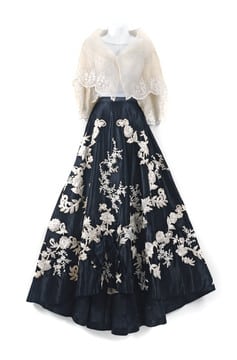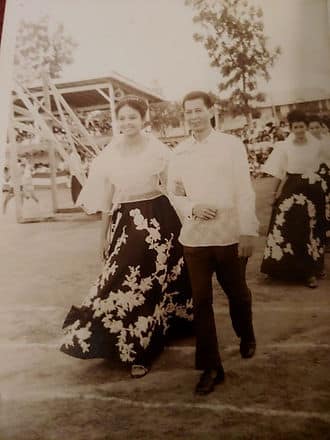Presented by Museum of the Peace Corps Experience and American University Museum
c. 1963
Philippines
Satin, white applique, other fabric, 64 x 60 in.
Collection, Museum of the Peace Corps Experience
Gift of Ann Jealous, Philippines, Siniloan 1963–65

While settling into teaching with my Filipina co-teacher, Helen (whose family I eventually lived with) I noticed similarities and differences between our cultures. Filipinos embraced values I shared, including family, justice, friendship, community, hard work, and trust in God.
I no longer felt the urgency of time: I carried a book so I could read while waiting an hour for a bus to arrive or a social function to begin. Filipinos value feelings more than things, and it was good to learn that I could be happy with few possessions. People tended to accept realities they could not change.
As a tragic consequence of 333 years of Spanish colonization and 48 years as a US colony, light complexions were favored and Spanish ancestry was judged more positively than indigenous. This focus on skin color differences was very familiar to me as an African American. When I walked in the sun, a fellow teacher would hold an umbrella over my head so I would “stay beautiful.” Of the two young children in my family, Anabel, the one with the lighter complexion, was pronounced “beautiful,” while her darker-skinned sister Beverlyn’s beauty was never mentioned.
In December 1963, teachers in our district dance troupe surprised me with a Maria Clara gown. A traditional Filipino dress—also known as traje de mestiza (mixed heritage) because it incorporates indigenous and Spanish influences—it’s named for the mother of national hero José Rizal, who led the revolt against Spanish colonial rule in the 1890s. The dress, like me, is a mixture of Black and White heritages. I danced in that dress for nearly two years, and although I’ve worn it only a few times in the US, it is one of my most cherished gifts.
Peace Corps training had not prepared us for the impact of leaving people with whom we’d formed such deep relationships. One image continues to break my heart. Helen wrote me that after I returned to America, Anabel left home on several occasions to nurse her feelings of abandonment. The family would find her standing in the rain at the bus stop, waiting for her Tita Ann to return.
I’ll always be grateful for the impact the Philippines and its people had on me. And I’ll forever treasure the memory of folk dancing with my fellow teachers in my Maria Clara gown.

The Committee for a Museum of the Peace Corps Experience is a 501(c)(3) private nonprofit organization. Tax ID: EIN # 93-1289853
The Museum is not affiliated with the U.S. Peace Corps and not acting on behalf of the U.S. Peace Corps.
Museum of the Peace Corps Experience © 2024. All Rights Reserved.